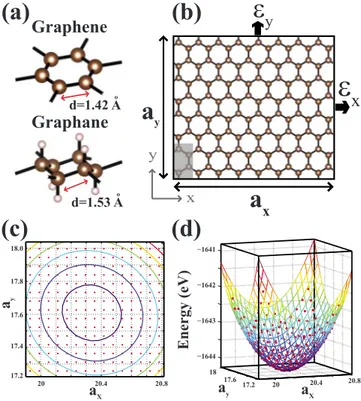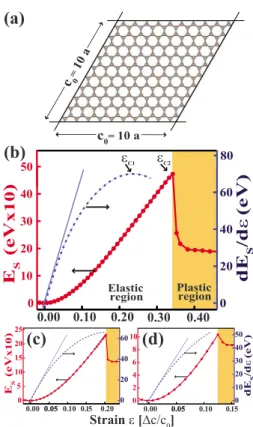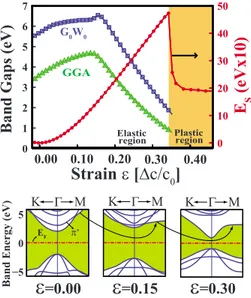The response of mechanical and electronic properties of graphane
to the elastic strain
M. Topsakal,1,a兲S. Cahangirov,1and S. Ciraci1,2
1UNAM-Institute of Materials Science and Nanotechnology, Bilkent University, Ankara 06800, Turkey
2Department of Physics, Bilkent University, Ankara 06800, Turkey
共Received 30 October 2009; accepted 12 February 2010; published online 4 March 2010兲 Based on first-principles calculations, we resent a method to reveal the elastic properties of recently synthesized monolayer hydrocarbon, graphane. The in-plane stiffness and Poisson’s ratio values are found to be smaller than those of graphene, and its yielding strain decreases in the presence of various vacancy defects and also at high ambient temperature. We also found that the band gap can be strongly modified by applied strain in the elastic range. © 2010 American Institute of Physics. 关doi:10.1063/1.3353968兴
Two-dimensional共2D兲 monolayer honeycomb structures of graphene,1,2BN,3and silicon4offer remarkable properties and are promising materials for future applications. Honey-comb structure of graphene with sp2 bonding underlies the unusual mechanical properties providing very high in-plane strength. Graphene and its rolled up forms, carbon nanotubes are among the strongest and stiffest materials yet discovered in terms of tensile strength and elastic modulus.5,6Graphane, another member of honeycomb structures was theoretically predicted7and recently synthesized by exposing graphene to hydrogen plasma discharge.8 Here each carbon atom being bonded to one hydrogen atom is pulled out from the graphene plane and hence whole structure is buckled. Instead of being a semimetal like graphene, graphane is a wide band gap semiconductor and can attain permanent magnetic mo-ment through hydrogen vacancies.9
In this work, we revealed the relevant elastic constants of graphane using strain energy calculations in the harmonic elastic deformation range and compared them with those cal-culated for other honeycomb structures. We also found that in the presence of hydrogen vacancy and carbon+ hydrogen divacancy, its yielding occurs at smaller strains. Furthermore, its band gap first increases then decreases steadily with the increasing applied strain. We believe that our predictions are relevant for the current research focused on the electronic properties of honeycomb structures under strain.10,11
First-principles plane wave calculations are carried out within density functional theory using projector-augmented wave potentials.12 The exchange correlation potential is ap-proximated by generalized gradient approximation 共GGA兲 using PW91 functional. A plane-wave basis set with kinetic energy cutoff of 450 eV is used. All atomic positions and lattice constants are optimized by using the conjugate gradi-ent method, where the total energy and atomic forces are minimized. Interactions between adjacent graphane layers in supercell geometry is hindered by a large spacing of⬃10 Å. To correct the energy bands and band gap values obtained by GGA, frequency-dependent G0W0 calculations are carried out. G0W0 corrections are obtained by using 共12⫻12⫻1兲 k-points in the Brillouin zone共BZ兲, 400 eV cut-off potential for G0W0, 160 bands, and 64 frequency grid points. All
nu-merical calculations are performed by using VASP package.13,14
The graphene has a 2D hexagonal unit cell with a lattice constant of a = 2.47 Å. The C–C bond length is d = 1.42 Å and all atoms lie in the same plane. Upon hydrogenation, the lattice constant increases to 2.54 Å and d increases to 1.53 Å. Moreover, C–H bonds are 1.11 Å and the amount of buckling between the alternating carbon atoms in a hexagon is 0.46 Å. Atomic configuration of graphene and graphane structures are shown in Fig.1共a兲.
The elastic properties of homogeneous and isotropic ma-terials can be represented by two independent constants,
a兲Electronic mail: topsakal@nano.org.tr.
Energy (eV) aX ay
a
xa
yGraphene
Graphane
ε
x
ε
y
y x 20 20.4 20.8 −1644 −1643 −1642 −1641 18 17.6 17.2 18.0 17.8 17.6 17.4 17.2 aX ay 20 20.4 20.8 d=1.42 Ao d=1.53 Ao(a)
(b)
(c)
(d)
FIG. 1. 共Color online兲 共a兲 Schematic representation of the atomic structure of graphene and graphane.共b兲 共8⫻4兲 rectangular supercell configuration of the system containing 128 C-H pairs used for the calculation of the elastic constants. ax and ay are the lattice constants of the supercell in x- and
y-directions. Shaded region is the smallest unit cell.共c兲 The mesh of data
points共ax, ay兲 used for the total energy calculations. The units are given in
angstroms.共d兲 The three-dimensional plot of ax, ayand corresponding total
energy values. The red balls are actual points and the lines are the fitted formula.
APPLIED PHYSICS LETTERS 96, 091912共2010兲
Young’s modulus Y and Poisson’s ratio. Since the thickness of a monolayer structure h is ambiguous, the in-plane stiffness C is a better measure of the strength rather than Young’s modulus. Defining A0as the equilibrium area of the system, the in-plane stiffness can be given as, C =共1/A0兲 ⫻共共2E
S/⑀2兲兲, where ES is the strain energy calculated by subtracting the total energy of the strained system from the equilibrium total energy and ⑀ is the uniaxial strain 共⑀=⌬a/a, a being the lattice constant兲. The Poisson’s ratio which is the ratio of the transverse strain to the axial strain can be defined straightforwardly as = −⑀trans/⑀axial.
For calculation of elastic constants of graphane, we con-sider large supercell comprising 32 rectangular unit cells 共8⫻4兲. The calculations are also repeated in 共2⫻1兲, 共4⫻2兲, and 共6⫻3兲 supercells and the obtained results are almost identical, since no reconstructions are observed in the system. Figure 1共b兲shows the supercell used in the calcula-tions. axand ayare the lattice constants of the supercell in
x- and y-directions in any strain condition. In the harmonic
region, a
⬘
s are varied with the strain values between +/−0.02. A grid data共ax; ay兲 containing 225 points is obtained as shown in Fig.1共c兲. For each grid point, the corresponding supercell is fully optimized and its total energy is calculated as shown in Fig.1共d兲. By using the least-squares method, the data is fitted to the formula, ES= a1⑀x
2 + a2⑀y
2
+ a3⑀x⑀y; where⑀x and⑀y are the small strains along x- and y-directions in the harmonic region. As a result of isotropy in the honeycomb symmetry, a1 is equal to a2. The same equation can be obtained from elasticity matrix15in terms of elastic stiffness constants, namely, a1= a2=共h·A0/2兲·C11; a3=共h·A0兲·C12. Hence one obtains Poisson’s ratio which is equal to
C12/C11= a3/2a1. Similarly, the in-plane stiffness, C = h · C11·关1−共C11/C12兲2兴=关2a1−共a3兲2/2a1兴/共A0兲. The calcu-lated values of C by using the present method for graphane, graphene, BN, Si, and SiC 2D honeycomb structures are, respectively, 243, 335, 267, 62, and 166 J/m2. Also the cal-culated Poisson’s ratios are 0.07, 0.16, 0.21, 0.30, and 0.29. Our calculated value of the in-plane stiffness of graphene is in good agreement with the experimental value5 of 340⫾50 N/m and justifies the reliability of our method. As seen from the calculated values, the change of the bonding type from sp2 to sp3and buckling of the atoms in graphane structure makes it 27% less stiffer than graphene. This dif-ference can be used to distinguish graphene and graphane materials. Also the Poisson’s ratio of graphane is almost half of the Poisson’s ratio of graphene, since the buckled struc-ture of graphane reduces the transverse contraction. Note that depending on their types and concentrations the defects can alter the above elastic constants. For example, a C2H2-vacancy for the structure in Fig.1共b兲 breaks the isot-ropy and can reduce C by ⬃12% in a specific direction. Hydrogen frustration8,16can also be a crucial type of defect, which would affect C, since the structure is locally com-pressed and A0is influenced.
We next consider the behavior of the system for higher values of the strain ranging from ⫺0.02 to 0.45 in uniform expansion. For this purpose, we preferred a fully symmetric hexagonal lattice with well defined high symmetry points in the BZ. Again the calculations are performed in a large 共10⫻10兲 supercell as shown in Fig. 2共a兲. The harmonic re-gion can be taken between −0.02⬍⑀⬍0.02 and it is fol-lowed by an anharmonic region where higher order terms are
not negligible in the strain energy equation. The anharmonic region is followed by a plastic region where irreversible structural changes occur in the system and it transforms into a different structure after the yielding point. Figure 2共b兲 is the plot of strain energy ES and its derivative 关dES共⑀兲/d⑀兴 with respect to the applied strain. Two critical strain values can be deduced from the plots. The first one,⑀c1, is the point where the derivative curve attains its maximum value and then starts to decrease. It occurs nearly at⑀= 0.23, where the C–C bond length is around 1.87 Å. This means that for ⑀ ⬎⑀c1, the structure can be expanded under smaller tensions. The phonon frequencies, we calculated by using the force constant method17 are all positive throughout the BZ for⑀ ⬍⑀c1, but the frequencies of longitudinal acoustic modes start to become imaginary for ⑀⬎⑀c1, indicating an instabil-ity of 2D graphane under uniform expansion beyond ⑀c1. Such phenomena is known as “phonon instability,”18,19 where phonon frequencies⍀n共k兲, get imaginary for specific wave vector k and branch index n. A detailed discussion can be found in Ref. 18 and the references therein. Liu et al.18 calculated the critical strain values for graphene as 0.194 and 0.266 for uniaxial tension in zigzag 共x-兲 and armchair 共y-兲 directions by using density functional perturbation theory.
The second critical point⑀c2is the yielding point which is around⑀= 0.34. The C–C distance corresponding to⑀c2 is 2.02 Å. Up to this point, the strain energy always increases and the system preserves its honeycomblike structure. Upon the release of the tension, all the deformation disappears and hence the system may return to its original size at⑀= 0.
Fur-c=0 10 a c0=10 a 0 10 20 30 40 0 20 40 60
E
S(eV
x10)
Strainε [∆c/c0] 0.00 0.10 0.20 0.30 0.40 εC1 εC2dE
S/d
ε
(eV)
80 50(a)
(b)
Plastic region Elastic region 0.00 0.05 0.10 0.15 0.20 0 5 10 15 20 25 0.05 0 20 40 60 0.00 0.05 0.10 0.15 0 2 4 6 8 10 0.05 0 10 20 30 40 50 ES (eV x10 ) dE S /d ε (eV)(c)
(d)
FIG. 2. 共Color online兲 2D graphane under uniform expansion. 共a兲 Initial atomic configuration in a共10⫻10兲 supercell treated with periodic boundary condition. 共b兲 The variation in strain energy ES and its derivative. The
orange/shaded region indicating the plastic range. Strains corresponding to two critical points in the elastic range are labeled as⑀c
1and⑀c2.共c兲 Similar
to 共b兲 for a single H-vacancy in a 共10⫻10兲 supercell. 共d兲 For C + H-divacancy in a共10⫻10兲 supercell.
thermore, the value of ⑀c2 is found to depend on various defects and the temperature of the system. For H-vacancy, we found that⑀c2is lowered to⬃0.21 as shown in Fig.2共c兲. As for C + H-vacancy, which corresponds to a hole at one corner of hexagon,⑀c2is further lowered to 0.13 as shown in Fig.2共d兲. We also examined the effect of ambient tempera-ture on the yielding strain. Ab initio molecular dynamic cal-culations 共lasting 2 ps with time steps of 2⫻10−15 s兲 indi-cate that ⑀c2= 0.34 corresponding to T = 0 K is reduced to 0.20 at T = 300 K and is further reduced to 0.18 at T = 600 K. Apparently, the yielding of perfect graphane under uniform strain at⑀c2can only occur for ideal conditions. For ⑀c1⬍⑀⬍⑀c2 the system is in a metastable state. The long wavelength perturbations, vacancy defects, as well as high temperature effects lead ⑀c2 decrease to the strain values around⑀c1. After the yielding point, where⑀ⱖ⑀c2, the plastic range sets in with irreversible deformations. This range, however, is beyond the scope of this paper.
We finally investigate the variation in the electronic properties of graphane with the uniform strain. The effect of strain on the buckling is found to be minute. It decreases from 0.46 to 0.43 Å as⑀increases from 0 to 0.30. Also, C–H bonds are shortened only 1% in this range of strain. The binding energy of a single hydrogen in 共10⫻10兲 supercell increases from 4.79 to 5.02 up to ⑀= 0.20. Normally, graphane is a semiconductor with a wide direct band gap of 3.54 eV calculated by DFT-GGA, but our calculations show that this gap can increase to 5.66 eV after G0W0corrections.
On the other hand, recent GW0 共5.97 eV兲 共Ref. 9兲 and GW
共5.4 eV兲 共Ref.20兲 corrections report slightly different values
depending on the method and parameters used. More re-cently DFT-LDA calculations21 found the band gap as 3.6 eV. Figure3shows the variation in GGA and G0W0band gap values with respect to the strain for uniform expansion in the elastic region. While the lowest conduction band is raised with strain in the first and second panels; in the third panel, the second ⴱ band is lowered steadily and dips in the gap for ⑀⬎0.15. Dramatic variation in the band gap with the strain suggests that graphane can be used as a strain gauge at nanoscale.
In summary, we revealed the elastic constants of graphane indicating that it has a quite high in-plane stiffness and very low, perhaps the lowest Poisson’s ratio among known monolayer honeycomb structures. We showed that the band gap of graphane can be modified significantly by applied strain in the elastic range. It is suggested that elastic deformation can be used for further functionalization of graphane and hence for monitoring its chemical and elec-tronic properties.
Part of the computations have been provided by UY-BHM at Istanbul Technical University through Grant No. 2-024-2007.
1K. S. Novoselov, A. K. Geim, S. V. Morozov, D. Jiang, Y. Zhang, S. V. Dubonos, I. V. Grigorieva, and A. A. Firsov,Science 306, 666共2004兲.
2Y. Zhang, Y.-W. Tan, H. L. Stormer, and P. Kim,Nature共London兲 438, 201共2005兲.
3C. Jin, F. Lin, K. Suenaga, and S. Iijima,Phys. Rev. Lett. 102, 195505 共2009兲.
4S. Cahangirov, M. Topsakal, E. Akturk, H. Şahin, and S. Ciraci,Phys.
Rev. Lett. 102, 236804共2009兲.
5C. Lee, X. Wei, J. W. Kysar, and J. Hone,Science 321, 385共2008兲. 6Q. Zhao, M. B. Nardelli, and J. Bernholc, Phys. Rev. B 65, 144105
共2002兲.
7J. O. Sofo, A. S. Chaudhari, and G. D. Barber,Phys. Rev. B 75, 153401 共2007兲.
8D. C. Elias, R. R. Nair, T. M. G. Mohiuddin, S. V. Morozov, P. Blake, M. P. Halsall, A. C. Ferrari, D. W. Boukhvalov, M. I. Katsnelson, A. K. Geim, and K. S. Novoselov,Science 323, 610共2009兲.
9H. Şahin, C. Ataca, and S. Ciraci,Appl. Phys. Lett. 95, 222510共2009兲. 10V. M. Pereira and A. H. Castro Neto,Phys. Rev. Lett. 103, 046801共2009兲. 11M. Topsakal and S. Ciraci,Phys. Rev. B 81, 024107共2010兲.
12P. E. Blöchl,Phys. Rev. B 50, 17953共1994兲.
13G. Kresse and J. Furthmuller,Phys. Rev. B 54, 11169共1996兲. 14M. Shishkin and G. Kresse,Phys. Rev. B 74, 035101共2006兲. 15J. F. Nye, Physical Properties of Crystals共Clarendon, Oxford, 1985兲. 16M. Z. S. Flores, P. A. S. Autreto, S. B. Legoas, and D. S. Galvao,
Nano-technology 20, 465704共2009兲.
17D. Alfè,Comput. Phys. Commun. 180, 2622共2009兲. 18F. Liu, P. Ming, and J. Li,Phys. Rev. B 76, 064120共2007兲.
19X. Wei, B. Fragneaud, C. A. Marianetti, and J. W. Kysar,Phys. Rev. B 80, 205407共2009兲.
20S. Lebègue, M. Klintenberg, O. Eriksson, and M. I. Katsnelson,Phys. Rev.
B 79, 245117共2009兲.
21L. Liu and Z. Shen,Appl. Phys. Lett. 95, 252104共2009兲.
E
S)
0
1
x
V
e(
GGA 0 1 2 3 4 5 6 7 0 10 20 30 40 50Strain
ε [∆c/c
0]
0.00 0.10 0.20 0.30 0.40 Band G aps (eV ) G 0W0 Plastic region Elastic region −5 0 5 Band Energy (eV) Γ K M K Γ M K Γ M EFε
=0.00ε
=0.15ε
=0.30 π∗FIG. 3.共Color online兲 The variation in energy band gaps with 共2D兲 uniform expansion. The band gaps obtained both from GGA共green triangles兲 and
GoWo 共blue squares兲 calculations increase with increasing strain up to ⑀= 0.15, passes through a maximum, then decrease until the yielding point. The band gaps are given on the left and the strain energies are given on the right. Three panels show how the bands at the edge of conduction band are modified with strain.


